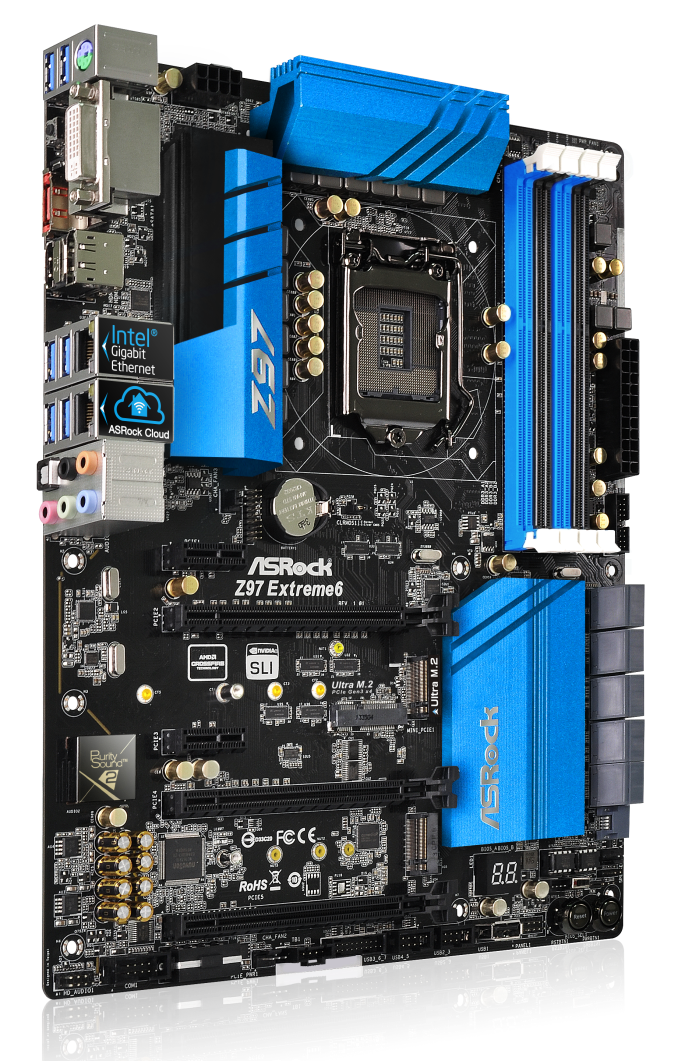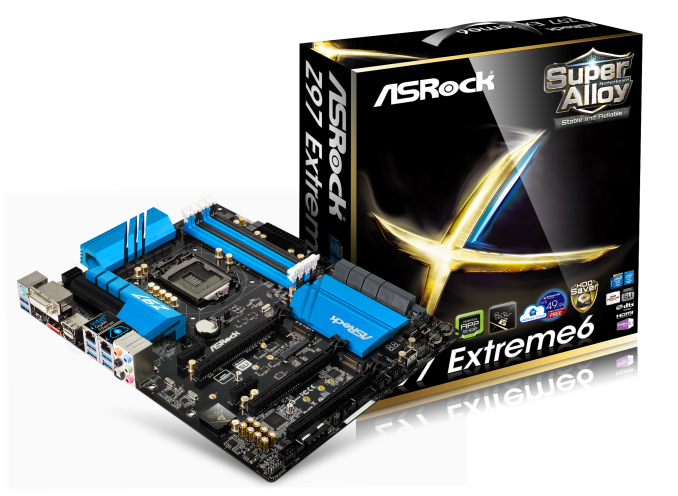ASRock Z97 Extreme6 Review: Ultra M.2 x4 Tested With XP941
by Ian Cutress on May 24, 2014 12:00 PM ESTASRock Z97 Extreme6 Conclusion
The big talking point for ASRock’s launch was the inclusion of that “Ultra M.2”, an M.2 x4 slot drawn off the CPU PCIe lanes. This is what I like to characterize as an ‘ASRock Jump’, a characteristic of ASRock to try new and different things. Some work, some do not, and others become part of the ASRock fold. I am glad that they have shown the M.2 x4 is a plausible asset to have, but unfortunately, like SATA Express, the main issue is having the hardware on the market to take advantage of it. The current M.2 drives on the market are mostly SATA based and not PCIe, and if they are to be PCIe they are most likely PCIe x2. Luckily we had an XP941 512GB, an OEM PCIe x4 SSD in to test with our review.
The two M.2 slots on the Z97 Extreme6 showed the effect of the PCIe x4 device when restricted by x2 lanes and allowed to stretch its legs with x4. With peak sequential results pointing to a +50% speed-up rather than a 3.2x that the lane bandwidth suggests, this gives SSD manufacturers more headroom to work with, and users faster drives. Although when the M.2 x4 is in use it brings the PCIe bandwidth of the first two slots down frame rates are not adversely affected at 1080p Max on our small test of a few modern titles. The major downside is that using the M.2 disables SLI, which is more a result of NVIDIA’s restriction for 8 lanes per GPU. So while the lack of drives on the market makes this almost a non-feature until later this year, it does set a very interesting precedent for other motherboard manufacturers (as well as ASRock) when they become more prevalent, or for a series of limited-GPU derived products that can siphon lanes into storage.
The specialist feature aside, the motherboard still has access to 10 SATA ports (some shared), 10 SATA USB 3.0 ports (using a controller and a hub) and enhanced Realtek ALC1150 sound. The vertical USB 2.0 port carries over from last generation and server builds, useful for verification dongles or any device that needs to be in the system permanently and away from small children at the back of the system. Next to this is a new feature called HDD Saver which, by using the cable in the box, can provide power to two SATA devices. These devices can be enabled and disabled via software in the OS, allowing users to create backups, save power or hide data from electronic attacks. The network capabilities stretch to two Ethernet ports, one Intel I218-V and one Realtek 8111GR.
The ASRock BIOS now has a Full HD mode allowing for 1920x1080 resolutions which also work on higher resolution monitors (although not by default). The color scheme of the BIOS has changed to match that of the motherboard, and in my eyes has lost some of the appeal of the last generation as the graphical icons are replaced with text. Much of the feature-set of the BIOS is the same as Z87 except for added options such as HDD Saver and My Favorites, accessible from the Main tab. The OC Tweaker tab is a single list of options that has now got too long, and ASRock should consider partitioning it up into separate menus. The software utilities now include the ASRock App Shop, an interface to download ASRock approved software and games as well as new BIOSes and drivers, and the Disk Monitor to give information about SATA devices installed.
In terms of performance, the ultra-low DPC Latency broke a new record (it has now been broken twice in two reviews) and the ASRock has plenty of automatic overclock options to keep everyone happy. Our overclocking test gave 4.6 GHz with our i7-4770K, limited by the temperature but in line with other motherboards we have tested. The initial POST time is a little long, a characteristic shared between many of the Z97 launch motherboards, however when controllers are disabled this moves down to below seven seconds.
For $170, there are going to be few motherboards that can boast 10 SATA ports and 10 USB 3.0, with access to multi-GPU configurations or an M.2 x4 slot. If we include the dual NICs and enhanced audio in that assessment, then it is plausible that one of the things missing is 802.11ac support, although users can add their own with the mini-PCIe integrated onboard. It makes me wonder why ASRock did not release a WiFi version of this motherboard. As with the other manufacturers, the biggest barrier ASRock has with the Z97 Extreme6 is that it uses storage features that have no products on the market, so users are buying into future possibilities with no guarantee which way the market will shift.
I am glad of the M.2 x4 being here, showing that it can be done and that this is the future. However it is hard to recommend a feature that cannot yet be exploited due to lack of product on the market. Given that ASRock has a history of making crazy storage options with their Extreme11 moniker, and there is no Z97 Extreme11 yet listed, I kind of want them to use a PLX chip and siphon off 16 lanes into a four M.2 x4 drive bay or something equally as ‘extreme’. I hope to see something like that (or this) at Computex. But again, we would have to await the drives to actually come to market.












43 Comments
View All Comments
457R4LDR34DKN07 - Saturday, May 24, 2014 - link
The Gen2 M.2 x4 PCIe looks very impressive. Its too bad that Asrock did not include this in their mITX offering.457R4LDR34DKN07 - Saturday, May 24, 2014 - link
I mean Gen3smoohta - Saturday, May 24, 2014 - link
Regarding the Dolphin benchmark- you wrote:"Results are given in minutes, where the Wii itself scores 17.53; meaning that anything above this is faster than an actual Wii for processing Wii code, albeit emulated."
This should read "... meaning that anything below this is faster than..." - right?
Ian Cutress - Saturday, May 24, 2014 - link
Bad choice of words - anything 'above on the graph' would be faster based on the orientation of results. I've updated it to remove the ambiguity. Thanks for pointing it out :)Ian
r3loaded - Saturday, May 24, 2014 - link
The overarching conclusion from this review - Intel needs to put far more PCIe 3..0 lanes on their CPUs and chipsets if we want motherboards where connectors don't play musical chairs with each other for bandwidth. Also, Samsung needs to make the XP941 a retail product right now!Tunnah - Saturday, May 24, 2014 - link
I think the reasoning behind an either/or situation with M.2/SATAe is sound - the consumer most likely will not require 2 high end SSDs, and will go with one that is either M.2 or SATAe, the rest can be served via normal SATA ports.Also I think SATAe, while a great idea, will lose out to the convenience and capability of M.2; SATAe would have been great 2 years ago but now M.2 is here it is absolutely perfect for an OS drive, cutting down on not just size but cabling.
SirKnobsworth - Sunday, May 25, 2014 - link
Agreed about SATAe, especially since (a) SSDs don't really need that much circuit board area and (b) A RAID array of two SATA SSDs offers at least as much theoretical bandwidth as a SATAe while taking up the same amount of ports on your board.Babar Javied - Sunday, May 25, 2014 - link
Exactly my thought. So why have SATAe???? Its great that it uses PCI but it doesn't really offer anything that we couldn't already do.As you've said, "A RAID array of two SATA SSDs offers at least as much theoretical bandwidth as a SATAe while taking up the same amount of ports on your board".
There seems to be a lot of stupid decisions being made regarding ports. DDR4 is another example of a useless upgrade.
Death666Angel - Tuesday, May 27, 2014 - link
"A RAID array of two SATA SSDs offers at least as much theoretical bandwidth" But your are losing random performance when going RAID and increase the chance of a disk failure. Why would you even compare them?Galatian - Saturday, May 24, 2014 - link
Ian,Can you explain to me why no mainboard manufacturer is using 4 lanes from the chipsets PCIe 2.0? I mean that would be enough for the Samsung SSD and still has room left. I mean what do I gain from all those SATA and USB ports? Who is actually using all of them?
Right now I have to choose between either a slow M.2 slot because they only allocate 2 lanes or I can go with ASRock which feels like overkill and takes away CPU PCIe lanes.